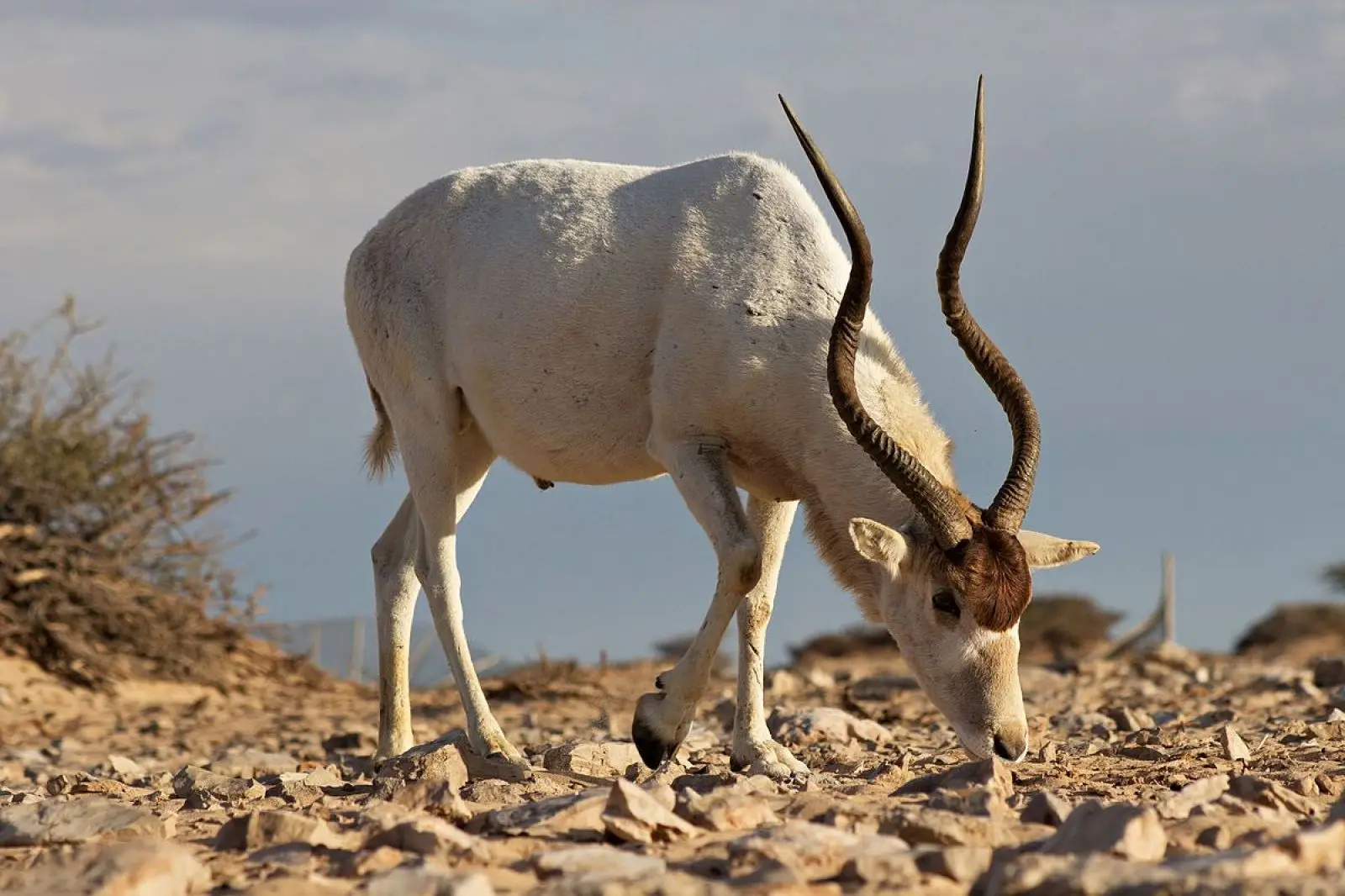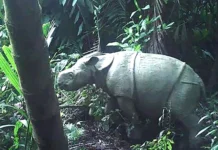The Addax (Addax antelopes) is a critically endangered species of antelope native to the harsh, arid regions of North Africa. With fewer than 100 individuals remaining in the wild, the Addax is considered one of the most at-risk species in the world. These desert-dwelling creatures, known for their striking appearance and extraordinary adaptations to life in the desert, are now facing an uncertain future due to a variety of factors.

In this article, we will explore the biology, behavior, and adaptations of the Addax, as well as the challenges the species faces and the ongoing conservation efforts to prevent its extinction.
Physical Characteristics of the Addax
The Addax is a medium-sized antelope that stands approximately 85 to 105 centimeters (33 to 41 inches) at the shoulder and weighs between 100 and 120 kilograms (220 to 265 pounds). One of the most distinctive features of the Addax is its long, spiraling horns, which are found in both males and females. These horns can grow up to 1 meter (3.3 feet) in length and are typically covered with a series of twists and turns, giving them a unique appearance. The horns are used primarily by males during mating displays and territorial fights.
The Addax has a pale, sandy coat that helps it blend in with the desert environment. Its fur changes color depending on the season, becoming lighter during the hot desert summers and darker in the cooler winter months. This color adaptation helps the Addax regulate its body temperature in extreme environments.
The Addax’s large, wide hooves are well-suited for traversing the soft, sandy terrain of the desert. They provide stability and allow the antelope to move across the shifting sands with ease, while its long, powerful legs are built for endurance over long distances.
Habitat and Distribution
Historically, the Addax was found across vast areas of the Sahara Desert, ranging from Morocco and Mauritania in the west to Chad and Sudan in the east. However, human activity and environmental changes have significantly reduced its range, and today, the Addax is primarily confined to small, isolated pockets in the deserts of southern Algeria, Niger, and Chad.
The harsh desert environment is a challenging habitat, characterized by extreme temperatures, scarce water sources, and limited vegetation. Despite these challenges, the Addax has evolved remarkable adaptations that allow it to survive in such a harsh environment.
Adaptations to Desert Life
The Addax is an extraordinary survivor of the desert, thanks to a series of specialized adaptations that help it thrive in an environment with limited water and harsh temperatures.
- Water Conservation: One of the Addax’s most impressive adaptations is its ability to go without water for long periods. It obtains most of its moisture from the vegetation it consumes, and when water is scarce, it can survive for weeks without drinking. The Addax is also capable of withstanding extremely high temperatures, and its body temperature can fluctuate by several degrees throughout the day and night to avoid overheating. This unique ability allows the Addax to survive in the desert’s harsh conditions, where other animals would struggle to survive.
- Efficient Metabolism: The Addax has a slow metabolism that enables it to conserve energy and survive on a diet of desert plants. These plants are often low in nutrients, so the Addax has evolved to be able to extract as much nutrition as possible from its food. Additionally, the Addax’s digestive system is specially adapted to maximize nutrient absorption from its food, making it highly efficient at obtaining the sustenance it needs.
- Specialized Hooves: The hooves of the Addax are well-suited for desert life. Large and wide, they help the Addax move through the sandy terrain without sinking into the soft ground. This adaptation is particularly useful in the shifting sands of the desert, where other animals might find it difficult to travel.
- Coat Coloration: The Addax’s coat coloration also plays an important role in its survival. The light color of the fur helps reflect the intense heat of the desert sun, while the darker coloration during the cooler months helps absorb heat and conserve warmth when temperatures drop.
- Endurance: The Addax is an excellent runner, capable of covering long distances at a steady pace. This endurance is essential in the desert, where food and water sources are spread out, and the Addax needs to be able to travel long distances to find them.
Behavior and Diet
Addaxes are generally solitary animals, though they can sometimes be found in small groups, especially during the mating season. These animals are primarily nocturnal, as they avoid the extreme heat of the day by foraging for food during the cooler hours of the evening and night.
The Addax is a herbivore, and its diet consists mainly of desert grasses, leaves, and shrubs. During periods of drought, it may also feed on saltbush, a plant that is adapted to arid conditions. The Addax’s diet varies depending on the availability of food sources, and the animal may travel long distances in search of food.
Although the Addax is capable of surviving without water for extended periods, it is still dependent on finding water sources, especially during the breeding season. The species is often found near oases or waterholes, which are vital to its survival in the desert.
Reproduction and Life Cycle
The Addax has a low reproductive rate, with females giving birth to a single calf after a gestation period of about eight months. Calves are born in the spring, and they are highly dependent on their mothers for the first few months of their lives. At birth, calves weigh around 5 to 7 kilograms (11 to 15 pounds) and are able to stand and walk shortly after birth.
The mating season for Addaxes usually occurs during the winter months, and males compete for the attention of females through displays of their horns and physical strength. Males will challenge one another for dominance, and the victorious male earns the right to mate with a female.
Addax calves grow quickly and are weaned after about six months. However, they remain with their mothers for the first year of their life, learning important survival skills. After that, they become more independent, although they may still stay within the general area of their mother’s range.
Threats to the Addax Population
The Addax population has experienced a significant decline over the last century due to a variety of human-induced factors. The main threats to the Addax include:
- Habitat Loss: The expansion of human settlements, agriculture, and infrastructure development in the desert regions has led to significant habitat loss for the Addax. This has reduced the available space for the species to roam and find food, making survival even more difficult.
- Poaching: Addaxes have long been targeted by poachers for their meat and horns. Despite being a protected species in some regions, illegal hunting remains a major threat to the Addax population.
- Competition with Livestock: As human populations increase in desert areas, competition for resources between Addaxes and domesticated animals, such as goats and sheep, has intensified. Livestock can overgraze the land, leaving less food for native wildlife like the Addax.
- Climate Change: The desert ecosystem is already fragile, and climate change is exacerbating the challenges the Addax faces. Increased temperatures, droughts, and unpredictable rainfall patterns are all factors that impact the Addax’s ability to find food and water.
- Low Reproductive Rate: The Addax’s low reproductive rate, combined with its shrinking population, means that every individual is crucial to the survival of the species. This makes the Addax particularly vulnerable to extinction, as any loss of individuals can have a disproportionate impact on the population.
Conservation Efforts and the Road to Recovery
Given the critical status of the Addax, conservation organizations and governments have been working together to develop and implement strategies aimed at protecting the species and restoring its population. Some of the key efforts include:
- Protected Areas: Several protected areas in countries like Chad and Niger have been established to safeguard the remaining Addax populations. These areas are designed to provide a safe environment where the Addax can live without the threat of poaching or habitat destruction.
- Captive Breeding Programs: In some cases, Addaxes have been taken into captivity to establish breeding programs aimed at increasing the population. These programs focus on genetic diversity and ensure that the species has a sustainable future.
- Anti-Poaching Measures: Governments and wildlife organizations have implemented stricter anti-poaching measures in regions where Addaxes are found. This includes surveillance, law enforcement, and collaboration with local communities to prevent illegal hunting.
- Restoration of Habitat: Efforts are being made to restore and protect the Addax’s natural habitat by reducing livestock overgrazing, planting vegetation, and ensuring that water sources are available for the animals.
Conclusion
The Addax is a truly remarkable animal that has evolved to survive in one of the harshest environments on Earth. However, due to human activity and environmental pressures, the Addax population has dwindled to fewer than 100 individuals, making it one of the most endangered species in the world. Despite the significant challenges facing the species, there is hope that with continued conservation efforts, the Addax can be saved from extinction.
By working together to protect the Addax’s habitat, curb poaching, and increase breeding success, conservationists are giving this incredible desert antelope a fighting chance to thrive once again. The survival of the Addax serves as a reminder of the importance of preserving our planet’s biodiversity and ensuring that future generations will have the opportunity to witness these extraordinary creatures in the wild.





























